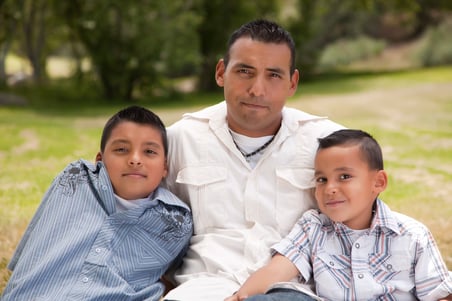Critical New Portrait of Latino Dads [Report & Resources]
3 min read
Date Published: 03/23/2017
Last Updated: 10/15/2021
National Fatherhood Initiative Blog / Latest Articles
3 min read

Before you read the rest of this post, grab a pen and paper and answer the following questions:
Stumped? If so, that's not a surprise. Until recently, we knew very little about the portrait of Latino fathers. The reason knowing the answers to the questions above is so vital is some of the characteristics in them influence the likelihood of any father's involvement in the life of his child. From a service-delivery perspective, it's important to know the answers for planning services and programs for Latino fathers.
That' why a recent report by the National Research Center on Hispanic Children & Families is so helpful to our understanding of just who are Latino fathers as a population. (I use the term "Latino" rather than "Hispanic" for consistency and because the former is used in the title of the report. The authors, however, use the terms interchangeably.) Analyzing data from the nationally representative National Survey of Family Growth, the authors created the following portrait of Latino fathers, taken directly from the report. Their analysis included a comparison of immigrant and U.S.-born fathers.
The report goes into much more detail about this portrait, so I encourage you to download and read it.
Given that most Latino fathers are immigrants and half are Spanish-dominant speakers, it's critical to provide programs and resources in Spanish as part of a comprehensive approach to serving this population. National Fatherhood Initiative® (NFI) has increased its collection of Spanish-language resources through the years (click here to view them) to meet the growing demand among organizations that seek to provide culturally- and linguistically-appropriate services and programs.
One of our most recent offerings is a Spanish-language Facilitator's Manual for our 24/7 Dad® A.M. and P.M. programs. (Program materials for fathers, such as the Fathering Handbook, have always been available in Spanish.) As demand has grown to serve Spanish speakers, organizations asked us for Spanish-language manuals to make it easier for bi-lingual facilitators to deliver the programs and, to help meet the growing demand to serve Spanish-speaking fathers, make it possible for Spanish-dominant or Spanish-only facilitators to deliver the program
To acquire Spanish-language manuals for either or both programs, please contact Jacquie Hannan, FatherSource™ Resource Center Director, at jhannan@fatherhood.org or 240-912-1263.
Does your organization serve Spanish-speaking fathers?
Are you aware of all the resources NFI has to help you serve these fathers? Check out our newest brochure, The Importance of an Involved Father, now available in Spanish.
Date Published: 03/23/2017
Last Updated: 10/15/2021
Download the ebook to learn how to create fatherhood initiatives that engage every sector of community life.

Train Your Staff
Fatherhood Programs
Fatherhood Data
© 2025 National Fatherhood Initiative®. All rights reserved.